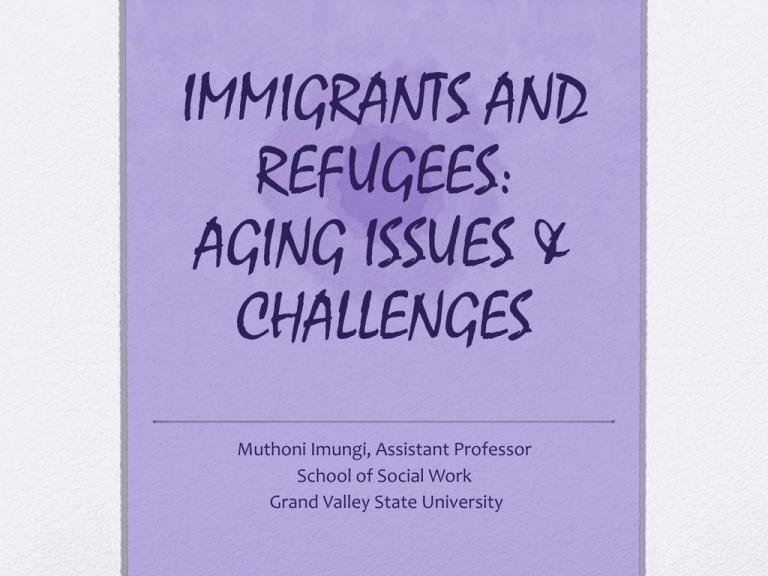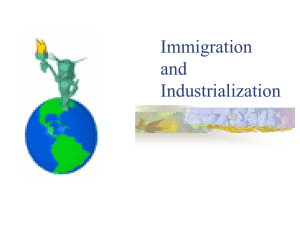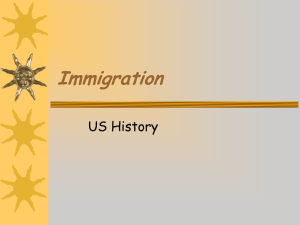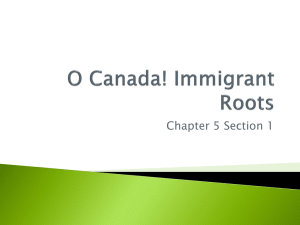Immigrants and Refugees - Grand Valley State University
advertisement

IMMIGRANTS AND REFUGEES: AGING ISSUES & CHALLENGES Muthoni Imungi, Assistant Professor School of Social Work Grand Valley State University DEFINITIONS • Who is a “REFUGEE” • 1951 Convention Relating to the Status of Refugees (28 July, 1951) defines a refugee as • Any person who is outside their country of origin and unable or unwilling to return there or to avail themselves of its protection, on account of a wellfounded fear of persecution for reasons of race, religion, nationality, membership of a particular group, or political opinion. DEFINITION • Who is an “IMMIGRANT” • An immigrant is anyone who moves from one country to another with the intention of settling there permanently DIFFERENCE BETWEEN THE TWO • IMMIGRANT • REFUGEE • Makes the decision to migrate • Is forced to migrate • Often safe journey • Arduous and dangerous journey taking days, months. • Is able to return to their home country • 37.9 million in 2007 • Most often do not have the ability to return home • 48,281 in 2007 U.S. IMMIGRATION POLICY • Three sets rules: 1 Govern legal migration, mainly family reunification or employment. U.S. citizens 21 or older could sponsor the immigration of their PARENT’S, as well as spouses and minor children. [IMMIGRANTS] 2 Govern humanitarian reasons for entering the U.S. i.e. those fleeing oppressive political regimes, parolees and those admitted during emergency situations [REFUGEES AND ASSYLUM SEEKERS]. 3 Govern illegal immigration [UNDOCUMENTED IMMIGRANTS] WELFARE POLICY INFLUENCE • Type of entry governs social welfare entitlements • REFUGEES • Are entitled to special assistance similar to those of U.S. citizens i.e. SSI, AFDC, TANF, Medicaid, food stamps (Refugee Act of 1980) • IMMIGRANTS • Are excluded from federally funded program for the first 5 years (PROWRA Act of 1996) WHY FOCUS ON OLDER ADULTS • In 1900s older adults comprised 5% of the population • According to a recent census older adults comprised 12.7% of the population or 33 million people • Trend towards a growing older adult population is expected to continue to rise as more adults live into late life OTHER CHANGES IN THE OLDER ADULT POPULATION • The older adult population will increase in diversity • Between 1990 and 2050 the non-white older adult population in the U.S. is projected to double from 10.2% to 21.3% (0thers 16% to 32.6%) • Between 1990 and 2050 the Asian population over the age of 65 increase by 625% followed by Hipsanic, Native American and African Americans at the rate of 150% • At the turn of the century, the non-Hispanic-white population will account for approximately 72% of the U.S. Population, by 2050 they will account for less than 53% of that same populatin REASON FOR DIVERSITY • Older adults resettled as refugees and immigrants • Aging of younger cohorts of immigrants • Immigration • Over the past 40 years immigration streams have shifted towards Africa, Asia and Latin America • Family reunification, enable older parents immigrate KNOWLEDGE GAPS • Little research on older adults in general because the comprise a small percentage of the population • Event less is known of the health or health trajectories in older immigrants and refugees • Increase in number of older immigrants and refugees in the U.S. presents a new challenge to practitioners and policy makers concerned with promoting healthy aging. AGING CHALLENGES IMMIGRANTS AND REFUGEES LANGUAGE • Many older adults who immigrate later in life from non-English speaking countries do not speak English • For example, in 20001 • 4.5% of older adult Asian Immigrants spoke English well • 42.8 spoke English less than very well • 18.6 had graduate/professional degrees • No research evidence suggests that older adults cannot successfully learn another language, however, evidence finds that it is easier for pre-pubescent children to acquire language faster and speak it without an accent ACCULTURATION • LANGUAGE • Lack of language hampers acculturation. • MOBILITY • Older adults may also be more home-bound resulting in less interaction with mainstream culture, thereby hampering acculturation • Older age at immigration is associated with lower levels of acculturation, acculturative stress and depression. • DIFFERING RATES OF ACCUTURATION • Differential rates of acculturation within families are source of distress • It is near impossible for older immigrants to achieve complete assimilation to a new culture LOSS • LOSS OF FAMILIARITY AND NETWORKS • Older adults had previously established roots, relationships and a familiar way of life in their home country • Moving to a new culture where they have few if any network and no established way of life can lead to feelings of loss • Feelings of loss and isolation are common • VIEW OF OLDER ADULTS • Many come from cultures where old age is equated with wisdom and privilege to a culture where it is associated with loss of productivity • Loss of status is experienced LIVING ARRANGEMENTS • MULTIGENERATIONAL LIVING ARRANGEMENTS • Most immigrants who arrive as older adults are sponsored by their adult children through family unification • Older adults are unlikely find employment or may not able to work. Without a source of income they often live with their children’s families • Having to share space with their young children is often a radically different living arrangement that can be a source of distress and depression • Multiple generation households can also lead to strained relationships • According to the 2000 U.S. census approx. 50% of immigrants 65 years and older lived in the homes of their children compared to 4% of older U.S. born immigrants LIVING ARRANGEMENTS • POOR HOUSING • Older adults immigrating in the past 20 years are likely to live in the inner city in substandard and overcrowded housing which sometimes lacks basic necessities • The living conditions have implications for • Physical health • Mental health • Safety HEALTH • PROWRA (1996) • Barred legal immigrants admitted after September 1996 from many federal and state benefits. States can also bar legal permanent resident aliens from TANF, AFDC and Medicaid. • This waiver is especially aimed at baring sponsored immigrants from becoming a public charge • Public welfare and immigration policy place responsibility for taking care of older adults solely on family members • Taking care of older adults can be especially burdensome to immigrants and refugees with limited social support and knowledge of resources • A study in Canada found that recent older adult immigrants, had poorer health than longer-domiciled immigrants or Canadian citizens HEALTH • Older adults may suffer poor health because • They are not be able to see health practitioners due to high cost and lack of insurance • Older adults may not mention their poor health for fear of further burdening the family • Lack of understanding of the health system and cultural norms may prevent their seeking health care MENTAL HEALTH • Isolation, limited language ability, loss, poor health can be a source of depression and anxiety among older adults • Refugees may especially be prone to poorer health and PTSD • Older adult immigrants however may not seek mental health services for these problems because they may not be familiar with the disorders or symptomatology ELDER ABUSE • The limited acculturation, language ability and income of older adults immigrants means that many of them will depend on family member for financial support, transport, language an cultural brokering. • This sense of responsibility can be overwhelming for family members that can lead to elder abuse • Physical Abuse • Financial abuse • Emotional abuse INTERVENTIONS INTERVENTIONS 1 Language classes tailored for older adult 2 Acculturation and adaptation services 3 Sensitization about mental health disorders 4 Access to culturally competent mental health and health practitioners 5 Funding for mental health and health care services 6 Adult day care services/friendship classes 7 Family preservation programs 8 Advocate for policy changes Research Interventions • To provide appropriate services to older immigrants from diverse backgrounds service providers need to understand their race/ethnicity, culture, immigration history, acculturation level and family relationships. • Need to understand health status and health behaviors Research • Little research looking at within group diversity • Asian immigrants constitute people from over 20 different nations • Most research aggregates cultural groups as one thereby masking important health disparities








